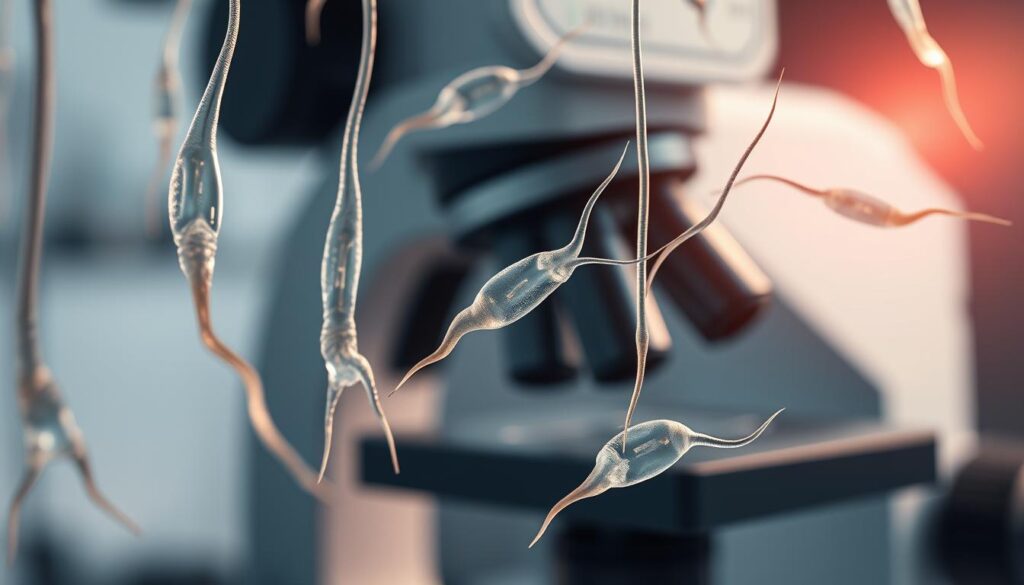Sperm survival time is key for reproductive health and fertility. It varies based on environmental conditions. Understanding sperm viability can affect conception planning and strategies.
Sperm cells are both tough and fragile. In the female reproductive tract, they can live up to 5 days12. Outside the body, they last only seconds to minutes when exposed to air2.
Medical procedures like IUI and IVF use special methods to extend sperm life. In labs, sperm can stay viable for up to 72 hours1.
Key Takeaways
- Sperm can survive up to 5 days inside the female reproductive system
- External environment dramatically reduces sperm survival time
- Medical procedures can extend sperm viability
- Sperm motility is critical for successful fertilization
- Environmental factors significantly impact sperm health
Understanding Sperm Survival in Different Environments
Sperm transportation depends on various environmental factors. Knowing how sperm survive can help you grasp reproductive health and fertility issues better.
Sperm cells are very sensitive to external conditions. Their survival relies on specific environmental factors that affect fertility3.
These factors provide key insights into reproductive health. Understanding them can help improve fertility outcomes.
Survival Time in Different Conditions
Sperm ejaculated outside the body have limited survival time. They usually live for a few minutes to hours in external environments3.
Key factors affecting sperm longevity include:
- Temperature conditions
- Moisture levels
- Exposure to air
- Surface type
Temperature Effects on Sperm Viability
Temperature is crucial for sperm survival. Extreme heat or cold can greatly reduce sperm viability3.
Your body provides the best environment for sperm. It maintains ideal conditions for their transport and potential fertilization.
| Environment | Sperm Survival Time |
|---|---|
| Female Reproductive System | Up to 5 days4 |
| Outside Body | Less than 1 hour4 |
| Cryopreserved | Up to 55 years4 |
Moisture and Environmental Factors
Moisture is vital for sperm survival. In warm, moist environments like the female reproductive tract, sperm live much longer.
Lifestyle choices, such as diet and exercise, can impact sperm health3. Dry surfaces are less hospitable for sperm.
Protecting sperm health requires understanding its delicate nature and environmental sensitivities.
Supplements like vitamin C, E, and omega-3 fatty acids can boost sperm quality. These nutrients help improve sperm longevity3.
Maintaining optimal conditions supports healthy sperm transport and fertility. This knowledge can help you make informed decisions about reproductive health.
How Long Can Sperm Live Outside the Body?
Sperm survival time is key for fertility awareness. Your sperm’s lifespan varies based on environmental conditions5. Outside the body, sperm typically survive for a surprisingly short time6.
In air, sperm usually die within minutes. This quick change in viability makes conception timing tricky5. Different surfaces affect sperm survival:
Sperm survival depends on initial health, temperature, and moisture. Medical experts can extend sperm life through special storage methods5. Frozen sperm can stay viable for longer, making it useful for fertility treatments6.
Sperm survival is a delicate process influenced by external conditions.
Surprisingly, sperm can live up to five days inside the female body5. This adaptation boosts the chances of successful fertilization during your fertile window.
Conclusion
Reproductive biology is delicate and complex. Sperm fertility depends on various factors that affect conception timing7. Understanding how environment impacts sperm can help you make smart reproductive choices8.
Environmental factors are key to sperm health. Temperature, moisture, and chemicals can quickly reduce sperm survival outside the body7. Surprisingly, sperm can live up to five days inside the female reproductive system8.
For those planning pregnancy, these details matter. Lifestyle choices can greatly influence sperm quality7. Managing stress, eating well, and avoiding heat can help.
Advanced methods like In Vitro Fertilization offer hope for fertility challenges7. Your reproductive health is always changing. Staying informed about sperm health can boost your chances of conception.
FAQ
How long can sperm survive outside the body?
Can sperm survive in water?
How long can sperm survive inside a woman’s body?
What factors affect sperm survival?
How long can medical professionals preserve sperm?
Does sperm motility impact its survival time?
How can I improve sperm health?
Source Links
- How Long Does Sperm Live Outside the Body? – https://www.healthline.com/health/how-long-can-sperm-live-outside-the-body
- The lifespan of sperm cells: Longevity, withdrawal, and fertility – https://www.medicalnewstoday.com/articles/319669
- Sperm Longevity — How Long Do Sperm Survive? – https://cryobankamerica.com/sperm-longevity-how-long-do-sperm-live/
- How Long Can Sperm Survive Outside & Inside the Body? – https://www.fertilityfamily.co.uk/blog/how-long-can-sperm-survive/
- How Long Does Sperm Live? | Ro Man – https://ro.co/fertility/how-long-does-sperm-live-in-out-of-body/
- Can you get pregnant in a hot tub from free-floating sperm? Why your chances are extremely low – https://www.businessinsider.com/guides/health/how-long-can-sperm-live-outside-the-body
- Understanding Sperm Survival: From Ejaculation to Fertilization – https://ivfturkey.com/can-sperm-survive-outside-the-body/
- How long does sperm live? | Conceive Plus® – https://conceiveplus.com/blogs/blog/how-long-does-sperm-live?srsltid=AfmBOor6hGE-MQi20Uqa0a2SKQIpX0PXUAv6HWhDPg45GR9VrPsvApwC
